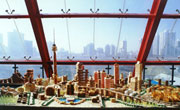- Dates
- —
Red aside. Contemporary Chinese Art from the Sigg Collection
The Joan Miró Foundation presents "Red aside", an exhibition of over 80 works - paintings, sculptures, installations, photographs and videos - by 51 contemporary Chinese artists, produced between 1986 and 2007 and selected from the collection formed by the Swiss businessman and diplomat Uli Sigg. The show aims to reflect the current state of Chinese art, in a period of huge economic and social changes with repercussions on a worldwide level. Since 1979, when the first economic reforms began, the development of the artistic scene in post-Mao China has been exceptional, although the conditions for achieving an independent output continue to be difficult. In recent years, the international art market has taken a particular interest in the new Chinese art and Chinese artists are commanding high prices. This means that the aesthetic value of some unusual and innovative works, of great technical quality and combining Eastern and Western traditions, can sometimes be overlooked. The selection of exhibits has been made by the Joan Miró Foundation with the assistance of Uli Sigg, and they are arranged in six sections that respond to the decisive influence of context in the work of contemporary Chinese artists:
Mao in the background
Works that refer to the current political situation in China, especially the strange phenomenon of the simultaneous veneration and questioning of the great leader.
Transformation: the new China
Works focusing on the great transformation of the urban and rural landscape of China as a consequence of the reforms that began in 1979 and that led to radical economic and social changes.
Personal stories: the new Chinese
Artists' responses to the impact of the changes covered in the preceding section on individuals and families at a social level.
New visions of ancient artistic traditions
This is the largest section, and includes sub-sections dedicated to calligraphy and to the female viewpoint. Artists have not only failed to abandon their specifically Chinese roots - from the pre-modern tradition to the Socialist Realism of the late 1970s - but in fact have revived and updated them in some of the most ambitious works produced in recent years.
A special kind of irony
There is a particularly strong ironic tone in the work of many Chinese artists, which probably derives from the tension between the still current socialist ideals and the arrival of the consumer society as a result of the economic reforms, and which they use to criticise the contradictions of the system.
Western art seen from China
Certain artists have appropriated some of the icons of European art - such as Delacroix, David, Duchamp - to illustrate their personal relationship with Western art.
There is also a space in the exhibition reserved for video, a medium that although not used in China until the 1990s now plays an important role in the country's art today.
At the opening ceremony, the conceptual artist Song Dong (Beijing, 1966) will present one of her installations, which under the generic title of Eating the city are a recreation in food of the city in which the exhibition is on show - in this case Barcelona. Afterwards, the public attending the opening will be able to "eat the city". This is an ephemeral, participatory project that the artist has successfully produced in other art museums around the world.
To tie in with "Red aside", a series of lectures has been organised to explore the theme of the exhibition in greater depth. Inma González Puy, director of the Instituto Cervantes in Beijing and the leading specialist in Spain on Chinese art, will give her view of the contemporary art scene in China, which she has experienced from its beginnings. Isabel Cervera, lecturer in oriental art at the Universidad Autónoma de Madrid, will hold a live interview with Uli Sigg, who will talk about the origins and development of the collection as well as the current relevance of Chinese artists. Finally, to close the cycle, three young Chinese artists will speak about their experiences as women in what is a predominantly male profession.
With this exhibition, the Joan Miró Foundation offers visitors the opportunity to get to know a selection of works from the Sigg Collection, the world's most important collection of contemporary Chinese art, and to see the paths forged by the country's new creative artists.


